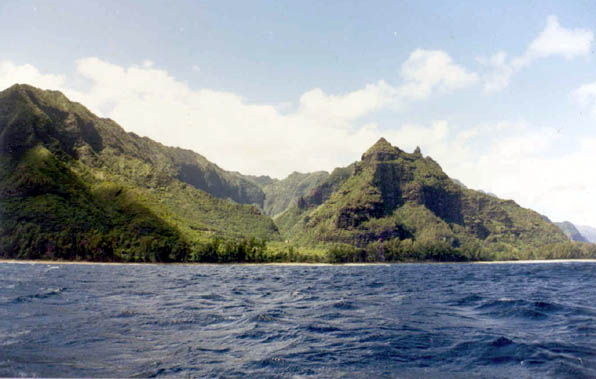 |
 |
 |
|||||
|
|
|
|
|
|
|
|
|
|
|
|||||||
Come land your canoe at Ha‘ena!
|
|||||||
|
"When the first people who came,they would have needed really safe anchorage. Not only in the sense that it was safe, but it had to be a place where they could sail into and sail out of, and not be blown up onto the land," says Carlos. "Because they had fairly good size canoes, which you wouldn't be able to paddle very well, so you had to come into a place where the direction of the wind allowed you to sail into the beach and off of the beach really quickly, in case the weather changed. "The bay here at Makua is like that, and fairly safe at least during the summer months. You have to find a place where the wind is flowing parallel to the beach, for those old canoes that cannot sail too well to windward. Now you can watch the windsurfers: they can tack right into the bay-in and out, in and out."
|
||
|
|
||
|
Ha‘ena is one of the sites within the Hawaiian Islands where there is definite evidence of very early settlement. For archaeologists, evidence lies buried in the sand dunes near the shore. But for Native Hawaiians, the tradition of people living here goes very far back. Back, in fact, before the arrival of Hawaiians themselves. The earliness of settlement here is attributed to the favorable locational factors at Ha‘ena. Chipper explains, "We have radiocarbon dating that clearly shows people living here--at least, evidence of them existing here, as far back as 200-300 AD, solid 500 AD, and some sites right here at the mouth dated to 2 to 3 hundred. "To me, that's not a coincidence, because I look at the people who came here as master mariners, and being such, they would have circumnavigated all the islands looking for where's the best place to live. What a lot of people don't realize, is when the arrived here, they found incredibly unique ecosystem, but within those ecosystems there was very little that could sustain them, other than the marine ecosystem. So we have a thousand species of plants endemic to Hawai‘i, but within those, we got akala-native raspberry, ohelo berries, some fern shoots, no major land mammals. "There were some flightless birds and such, but not a whole lot of terrestrial resources that could directly sustain them. Great abundance of water, but what was key was the marine resources for sustaining the people, until the plants that they brought with them in their voyaging canoes were able to flourish."
|
||
|
|
||
|
"The plants they brought with them—there are roughly 25 to 30 species that are believed they brought with them in their voyaging canoes—were the core of their culture. They were their food plants, their fiber plants, their medicine plants, their ritual plants. So to me, initially, they would have looked for a place with abundant marine resources, abundant fresh water, abundant rainfall to water their plants that they had brought with them on their voyages. "And land that could be easily planted and sustain these initial plants. So to me, a place like Ha'ena is perfect, because you have the reefs--the papa--the marine resources so abundant here, and easy to get to, close to water, close to a flat alluvial plane where you could plant your plants, abundant rainfall. Places like here, Bellows on O‘ahu is another place." Now we go to learn about the ancient peoples of Kaua'i.
|
||
|
|
||
| |
| |
|
|

| Ha'ena Home | Map Library | Site Map | Hawaiian Islands Home | Pacific Worlds Home |

|
|||
| Copyright 2001 Pacific Worlds & Associates • Usage Policy • Webmaster |
|||




